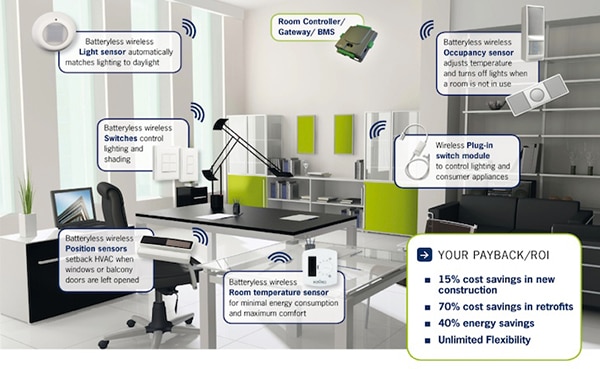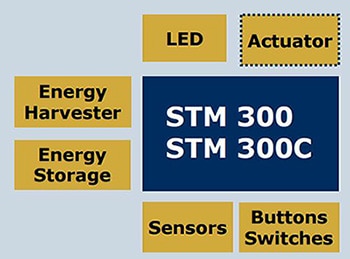Developing an Ecosystem for Energy Harvesting in Building Automation
投稿人:DigiKey 欧洲编辑
2015-11-19
Connecting up sensors in a building is an increasingly important feature of building automation. While there have been proprietary, closed systems in the past, now the Internet of Things (IoT) is offering the opportunity to open up building automation to a wider set of technologies. This Building Internet of Things (BIoT) has its own specifications to create a broad ecosystem of devices. Powering the sensors and communications links in the BIoT is a key challenge. Running power leads throughout a large building is expensive for capital budgets, while having to regularly change the batteries in sensor nodes is expensive for operating budgets. Harvesting energy from the environment in a number of different ways can dramatically reduce the costs of installing and maintaining a building automation system, helping to improve the return on investment. Adding Internet connectivity via a gateway or even for individual sensor nodes allows more granular monitoring and control, and opens up the opportunity for a new generation of software apps to further enhance the use of the devices. All this helps create a growing ecosystem of technology around the BIoT and building automation in general.
Using energy harvesting for building automation has the proven potential to make a serious dent on a building’s energy cost. This takes the argument on from using different sources of renewable energy to reducing the overall energy consumption. The UK’s National Energy Efficiency Action Plan, for example, includes ambitious goals of reducing primary energy consumption by 20% of the 2007 level by 2020.
The target is retrofitting large buildings, where 40% of the UK’s primary energy is consumed. Building automation is now a key part of the Building Renovation Strategy in the National Energy Efficiency Plan, to control systems such as heating, ventilation, lighting or shading in accordance with individual requirements.
This is not just about the individual control of temperature or humidity, but learning an occupant’s behavior automatically. Room sensors deliver data as a basis to analyze a building’s heating and cooling rate as well as its physical fabrics. Besides temperature, sensors can also detect open windows or whether the relative humidity of the air is too high. With this data, the system can automatically reduce the heating or activate the ventilation.
While in the past this was done in a central server in the building, now software out in the cloud performs this task. This data can be combined with current weather conditions, the presence of people in a room, solar radiation and so on to adapt to changing situations and conditions. The more accurate the cloud-based software becomes through learning patterns of activity, the greater the cost savings. The EnOcean Alliance, an umbrella group of building automation equipment suppliers, points to savings of up to 30%. The group, which has 350 manufacturing company members, defines standardized application profiles for batteryless wireless devices. This allows designs from different vendors to be easily connected in a system so that system architects, integrators and building operators can use the right pieces of equipment for their individual requirements.

Figure 1: Energy harvesting can be used to provide building automation without wires.
This combination of energy harvesting and wireless links means these monitoring and control systems can be easily retrofitted in existing buildings. In a new building, they reduce installation costs by 15 to 30% of installation costs, while in retrofit projects the savings can be up to 70%, says the EnOcean Alliance.
This also helps to meet the needs of flexible offices, where partition walls and the floor plans have to adapt to the needs of different departments or even different tenants. The switches and sensors can be easily moved whenever the office layout changes.
This provides different opportunities for harvesting the energy. Solar cells can be used to power sensors, taking their power from both daylight and the indoor lighting. This is usually backed by a rechargeable battery, using the cells to recharge the battery that only needs to be replaced every ten years. For example, if a solar power motion sensor such as the E9T-OSC from Illumra detects that a room is no longer occupied, it can switch off the lights and the air conditioning. This can save 30% of the energy cost compared to non-automated buildings.

Figure 2: Illumra’s E9T-OSC motion sensor can be solar powered for building automation.
For this to be effective, the wireless infrastructure has to take energy harvesting sources into account. This means having power management that can handle small amounts of variable power coming in, and storing it either in a capacitor or a rechargeable battery to provide the power for both the sensor and the wireless link. The link also has to adopt a balance between updating the data quickly and the power available. The EnOcean specification is key for this, as it defines effective ways to manage the communications links in a system specifically powered by energy harvesting sources. This is achieved with telegrams that contain the source of the data and the data itself to minimize the power consumed.

Figure 3: The EnOcean telegram protocol running on the STM300 module links energy harvesting sensors and actuators.
This can be easily added to sensors via a module such as EnOcean’s STM300 which has a built-in 16 MHz 8051 microcontroller. The module provides a user configurable cyclic wake up every 1, 10 or 100 seconds where a telegram is sent with the input data, unique 32-bit sensor ID and checksum if there has been any change. A wake up can also be triggered externally, for example if there is a large change. The module provides three analog-to-digital inputs and four digital inputs for connecting to the sensor, as well as a voltage limiter and threshold detector to handle the variable power from the energy harvesting source.
The next step is linking this to the Internet to create the BIoT and take advantage of managing the data in the cloud. The Smart Gateway from Digital Concepts translates the telegrams to the IP protocol and allows the sensors to communicate with other systems around the building via the open source AllJoyn protocol.
The commands and the application programming interface (API) of the gateway have been specifically developed to help the implementation of energy harvesting control systems throughout the building. A simple two-way TCP/IP communication is used to give the system integrator the choice between simple, string-based commands and more powerful JSON instruction. This is based on EnOcean’s Link middleware on the TCM300 module, which means that it can communicate with a wide range of sensors and actuators that use the same Link protocol.
An integrated SQL database is used to store the data about the devices, with an unlimited number of sensors and up to 128 actuators. Because this is all IP-enabled, a web interface can be used that can be easily accessed from a PC or a smartphone. It supports both energy harvesting as well as those elements with power supplies and has different types of messages for the control of the wireless devices and the gateway.
The technology has also been implemented across large buildings. The conversion of the Hotel Platzl in Munich, Germany, saw Wieland-Electric install lighting controls directly onto furniture while the hotel was running. This involved 1,300 radio switches that were powered by the switch itself and 180 radio switch actuators without any need for cutting or chiseling through walls.
Oventrop in Germany also used energy harvesting to tackle energy losses from ventilation and heating in a local hospital. It used a router to control radiator valves and window contacts across 200 clinic rooms. This saved approximately 800 kWh per room per year, with a return on investment in less than three years.
A number of other suppliers have been demonstrating how energy harvesting helps with building automation. For example, alphaEOS has developed a predictive heating control system that can be retrofitted onto radiators and underfloor heating. This can also be expanded to an integrated home control system using the EnOcean wireless protocol. Similarly, ID-RF, a French manufacturer of design smart home solutions, has been showing its NodOn home automation suite. This includes a wireless, batteryless remote controller, a Smart Plug to control electrical devices, and solar-powered sensors.
Conclusion
Using the energy available in the environment to power sensors and actuators provides a wide range of benefits for building automation. Linking these up via an efficient wireless protocol that is optimized for energy harvesting is providing control systems across large buildings without complex installation challenges. This network is then at the heart of the Building Internet of Things, using gateways to tap into cloud computing and allow more user-friendly interfaces, apps across multiple devices, and more complex data analysis.

免责声明:各个作者和/或论坛参与者在本网站发表的观点、看法和意见不代表 DigiKey 的观点、看法和意见,也不代表 DigiKey 官方政策。








